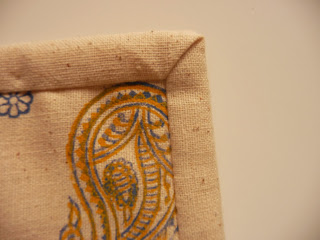As I've commented before Indian textiles are traditionally produced and don't seem to be innovative. They have a key place in the identity and culture of the Indian population.
But I'm not Indian and the textiles are not in any way sacrosanct so I'm going to mess with tradition a bit. I want a more contemporary product.
Choose one design idea to be developed towards a product.
I've decided to make a table mat and use the block printing techniques that have absorbed me so much.
The reason I've chosen this is because it's so hard to find attractive mats that fulfil all the necessary functions. They have to be:
washable
durable
attractive
have insulation properties
In addition the idea of a "product" raises the notion of consistency, cost (including time) and availability of materials.
In my research I've found that Chandni Chowk have a good range of block printed tableware. They are lovely but very traditional.
I expect the central print is done by the four metre length as I found in Sanganer. My attempt will be a one off so it will not be an all over design like this.
http://www.chandnichowk.co.uk/Site_pages_Fair_trade/InteriorsPages_Fair_Trade/Tablewear_Pages_Fair_Trade/Placemats_Napkins_Hand_Block_Printed_Fair_Trade.html
Many are really complex patterns and may be an acquired taste.
 |
When I look at stores like M&S it's all pretty pedestrian but at the moment there is a very definite slant towards Christmas goods.
In Stage 3 I made a printing block out of string and it was quite successful on paper. For my table mat I've considered using the same block on fabric.
 |
| My block |
 |
| Trying it out |
 |
| Using it on a tissue paper background |
However, I've abandoned that idea because the block is now well worn and considering it is string and PVA it may fail. I have several traditional wooden blocks and decided on a large paisley design. I also wanted to use my small flower from my trip to the museum in Sanganer
.
In Indian household textiles the base fabric is usually white. Because my printing will be comparatively simple I've considered using a patterned fabric for my base. I could tie dye or use some batik left over from a skirt but when I looked I didn't have enough.
I have a piece of osnaburg that has an interesting texture, is durable and could give the contemporary, homespun feel I'm looking for. Time to sample.
I tried both linear and random designs on paper and decided on random.
I thought gold paint might work on fabric but it didn't until I overprinted with colours.
 |
| Trial on paper |
 |
| Trial on paper |
I tried both linear and random designs on paper and decided on random.
 |
| Gold paint on osnaburg |
 |
| then overprinted - much better |
I thought gold paint might work on fabric but it didn't until I overprinted with colours.
 |
| I tried my flower block on some binding
In India the traditional way to attach the batting to a quilt is by many rows of running stitch. I was mindful of the time involved so did a test piece where I did running stitches and some machine lines as well. The hand stitching won hands down but took ages. On reflection I should have tried a decorative machine stitch that would have looked more substantial.
I knew that I'd have to make some mitred corners so I had a go and it worked quite well.
The tutorial I used was really clear. Find it at
http://www.youtube.com/watch?v=WsFOIndc3J8 So much for the sampling. Here's the finished place mat which has unintentionally become reversible. There are couple of things to record. Firstly it surprised me that the quilting took up so much material. I started with two identical pieces of fabric but after quilting they were about 2 cm different. Secondly I don't think the flowers on the binding are necessary; It overdoes things a bit; the plain binding on the sample is fine. This feels like a very reactionary piece of work but as a "product" it would have to be commercial so maybe that's OK. Although all the processes I've used are of Indian origin it is very different from the textile work that has inspired me but if it wasn't I'd just be copying. |








No comments:
Post a Comment